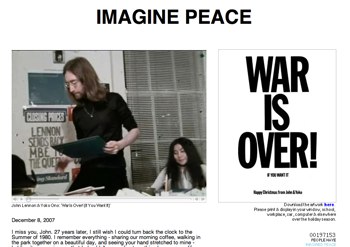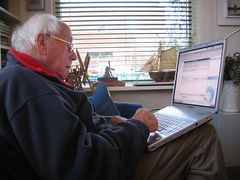I do not like to talk, here at 2¢ Worth, about activities with my clients unless they are very successful. It is not that I don’t want to talk about it, when things do not go well. I simply don’t want to reflect negatively on the client. So I usually wait a few weeks to talk about it, because there’s always something to be learned and shared, especially here.
This time, however, I want to go ahead. I believe that it might be in the interest of the teachers and administrators from Rose Tree Media School District who might be reading this, for me to have my say right now.
First, a little background. Rose Tree Media is implementing Pennsylvania’s Classrooms for the Future program, which provides funding for laptop computers in high school Math, Science, Language Arts, and Social Studies classrooms, as well as projectors and other technologies. It’s a good place for such a program. Their superintendent, Dr. Denise Kerr, seems not only to be a highly energetic and driven leader, but also extraordinarily creative. Think Mall School, just for a small indication of the outside the box orientation of her and her director of technology, Patti Linden, a woman who has been involved in instructional technology since the TRS-80.
 The day was part professional development and part celebration. After my address about how what we do with computers has more to do with contemporary literacy than with technology, they held a switch-throwing ceremony involving a brilliantly constructed giant light switch and twelve high school youngsters rolling 12 laptop carts down the isles of the auditorium.
The day was part professional development and part celebration. After my address about how what we do with computers has more to do with contemporary literacy than with technology, they held a switch-throwing ceremony involving a brilliantly constructed giant light switch and twelve high school youngsters rolling 12 laptop carts down the isles of the auditorium.
It was fun. The teachers and the kids enjoyed it. Then I moderated a student panel discussion with nine of the students (three had disappeared). I’ve talked about student panels before, about how they can be extremely useful and enlightening, or they may not be helpful. It depends on the students. After that experience, I’m coming to believe that student panels might actually set you back.
First of all, these were bright kids. They were funny and they were compelling — the kind of students any teacher would love to have in their class. But I could tell pretty early that things weren’t going where we wanted them to. My first question was, “How many of you use IM, text messaging, social networks, video games, etc.” The all raised their hands for IM and text messaging, and most raised their hands for Facebook (MySpace seems to be passe now). Only one, and finally two then three, admitted to playing video games.
I realized that many of the questions that I’d planned were not going to work, because I wanted us to learn what these kids were learning from their outside the classroom information experiences and how they were learning it. Instead, we learned that they all spent all of their time doing homework and considered video games a distraction, and the few minutes they spend with Facebook, they consider to be mindless interactions.
I finally asked, “How many of you consider yourselves ‘good students?'”
All nine raised their hands immediately, and a teacher behind me said, “These are all top-notch kids!”
Patti had arranged for a broad cross-section of students, but it was a day off for the kids, and arranging rides was a challenge, and three of the original twelve kids who rolled the carts down, apparently panicked at the crowd of teachers and fled out a side door. We had the “A” students who were enrolled in AP classes. These were the kids we don’t have to reach, the kids who do what they’re told and who have learned, from many years in the classroom, to tell us what they think we want to hear.
The harm of it? They reinforced those teachers who believe that we are doing just fine with our kids, doing things the same way we’ve always done them. I suspect that most teachers saw through what was happening and recognized that there is much more to learn from our students. But I still worry…
I’ve seen this work very well — In Ontario where they brought in “at risk” kids, and at the Council for Chief State School Officers conference in Maine where a couple of the panelists had just finished their Freshman year in college, and were reporting on their K-12 years from that perspective.
I’ve said that these things can be helpful — and they can. But I know now that you have to be very careful in selecting the kids, and you might even consider holding a pre-meeting with the panelists to orient them to what you’re looking for. You want to get out of the classroom and you want to talk about (learn from) the information experiences that are distracting to them and disrupting to us. We want to learn about those experiences.
For those teachers at Rose Tree Media, I say, “The kids you saw yesterday are easy.” What about the kids you are not reaching. What might their answers have been? Where are they, when you’re trying to teach about rhyme and meter, Caesar, plant cells, quadratic equations, and nutrition? They’re being reached by video games and social networks. Might we learn more about teaching today by learning more about those experiences?”
Added later:
Sylvia Martinez quite fairly calls me to task in her comment below, and a corresponding blog post, Don’t Blame the Kids. Well, I hope that it did not come across that I was blaming these kids. We were to blame for thinking that merely asking some kids some questions would help teachers understand something about a new generation of learner. As I said, I’ve seen this sort of panel work and work well. I know now that you have to come at it in a much more purposeful way, and, as Sylvia says so well, because it’s part of her “line,” that we learn about our children from their actions. As she says,
Kids shine when they share their work, and they get better at it when caring adults work with them to support their project development. They should be praised for real accomplishments and the ability to articulate them, not what happens to fall out their mouths. It’s a failure of adults not to create those conditions EVERY DAY.
The question remains, what are the best ways to start those conversations between information-oriented students and teachers who still see their classrooms as places for content delivery.

 The day was part professional development and part celebration. After my address about how what we do with computers has more to do with contemporary literacy than with technology, they held a switch-throwing ceremony involving a brilliantly constructed giant light switch and twelve high school youngsters rolling 12 laptop carts down the isles of the auditorium.
The day was part professional development and part celebration. After my address about how what we do with computers has more to do with contemporary literacy than with technology, they held a switch-throwing ceremony involving a brilliantly constructed giant light switch and twelve high school youngsters rolling 12 laptop carts down the isles of the auditorium.


 John Lennon (1940 – 1980) was murdered today, 27 years ago. His image, words, and impact continue today — and continue to be a resonating chord in the music of American and world culture.
John Lennon (1940 – 1980) was murdered today, 27 years ago. His image, words, and impact continue today — and continue to be a resonating chord in the music of American and world culture.
 Partly as an avoidance of the mountain of e-mail I have waiting for me, I took a little more than an hour, this morning, scanning through Google Reader. It may be the tail end of an exhausting travel schedule or perhaps I’m at the age, now, where I have the right to start thinking, sometimes longingly, about retirement, but my brain seemed to have turned around while I was reading and watching, thinking more about my own future and not just the future of our students.
Partly as an avoidance of the mountain of e-mail I have waiting for me, I took a little more than an hour, this morning, scanning through Google Reader. It may be the tail end of an exhausting travel schedule or perhaps I’m at the age, now, where I have the right to start thinking, sometimes longingly, about retirement, but my brain seemed to have turned around while I was reading and watching, thinking more about my own future and not just the future of our students.